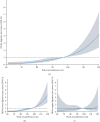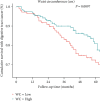The Association of Waist Circumference with the Prevalence and Survival of Digestive Tract Cancer in US Adults: A Population Study Based on Machine Learning Methods
- PMID: 36245841
- PMCID: PMC9562134
- DOI: 10.1155/2022/2492488
The Association of Waist Circumference with the Prevalence and Survival of Digestive Tract Cancer in US Adults: A Population Study Based on Machine Learning Methods
Abstract
Aims: This paper aims to investigate the relationship of waist circumference (WC) with digestive tract cancer morbidity and mortality.
Methods: Based on the data from a nationally representative US population survey, we summarized the prevalence of digestive tract cancer and all-cause mortality of cancer patients across WC quartiles. Adjusted logistic regression and restricted spline curve were used to analyze WC and the prevalence of digestive tract cancer. Moreover, Cox regression and the Kaplan-Meier curve were applied to investigate the association of WC with all-cause mortality. We also attempted to make a model to predict cancer happening.
Results: This paper included a total of 34,041 participants, with digestive tract cancer observed in 265 (0.7%) individuals. WC was positively associated with digestive tract cancer morbidity after full adjustment of covariates (OR: 1.72 and 95% CI: 1.41-2.10). Also, individuals in the highest WC group had a higher risk of digestive tract cancer (Q4, OR: 2.71 and 95% CI: 1.48-5.00). Moreover, no significant association was observed in upper digestive cancer, and WC was associated with a longer survival time once diagnosed (hazard ratio (HR): 0.50 and 95% CI: 0.28-0.92). Finally, the model we made proved to be effective.
Conclusion: High WC is a risk factor for digestive tract cancer with or without adjusting for body mass index, especially those located in the lower digestive tract. However, once digestive tract cancer has been diagnosed, patients with higher WC showed better survival outcomes. Moreover, machine learning methods can be used to predict digestive tract cancer risk in the future.
Copyright © 2022 Xingyu Jiang et al.
Conflict of interest statement
The authors declared no conflict of interest.
Figures





Similar articles
-
Strong Association of Waist Circumference (WC), Body Mass Index (BMI), Waist-to-Height Ratio (WHtR), and Waist-to-Hip Ratio (WHR) with Diabetes: A Population-Based Cross-Sectional Study in Jilin Province, China.J Diabetes Res. 2021 May 14;2021:8812431. doi: 10.1155/2021/8812431. eCollection 2021. J Diabetes Res. 2021. PMID: 34056007 Free PMC article.
-
Association Between Abdominal Waist Circumference and Blood Pressure In Brazilian Adolescents With Normal Body Mass Index: Waist circumference and blood pressure in Adolescents.Glob Heart. 2020 Apr 3;15(1):27. doi: 10.5334/gh.779. Glob Heart. 2020. PMID: 32489800 Free PMC article.
-
Body mass index, waist circumference, hip circumference, waist-hip-ratio and waist-height-ratio: which is the better discriminator of prevalent screen-detected diabetes in a Cameroonian population?Diabetes Res Clin Pract. 2015 Apr;108(1):23-30. doi: 10.1016/j.diabres.2015.01.032. Epub 2015 Jan 23. Diabetes Res Clin Pract. 2015. PMID: 25700625
-
Quotient of Waist Circumference and Body Mass Index: A Valuable Indicator for the High-Risk Phenotype of Obesity.Front Endocrinol (Lausanne). 2021 May 31;12:697437. doi: 10.3389/fendo.2021.697437. eCollection 2021. Front Endocrinol (Lausanne). 2021. PMID: 34135867 Free PMC article.
-
Body mass index, waist circumference, and waist-to-hip ratio as predictors of mortality in nonagenarians: the Vitality 90+ Study.J Gerontol A Biol Sci Med Sci. 2011 Nov;66(11):1244-50. doi: 10.1093/gerona/glr147. Epub 2011 Aug 22. J Gerontol A Biol Sci Med Sci. 2011. PMID: 21860016
Cited by
-
Impact of dietary patterns on the survival outcomes of patients with cardiovascular disease.Front Nutr. 2025 Jul 30;12:1535174. doi: 10.3389/fnut.2025.1535174. eCollection 2025. Front Nutr. 2025. PMID: 40808849 Free PMC article.
References
MeSH terms
LinkOut - more resources
Full Text Sources
Medical

